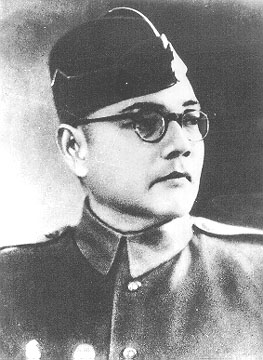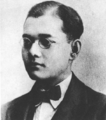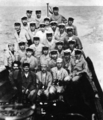Subhash Chandra Bose facts for kids
Quick facts for kids
Subhash Chandra Bose
|
|
|---|---|
| সুভাষচন্দ্র বসু | |

Subhas Chandra Bose
|
|
| Born |
Subash Chandra Bose
23 January 1897 |
| Died | August 18, 1945 (aged 48) Taipei (Taihoku), Japanese Taiwan
|
| Nationality | Indian |
| Education | Ravenshaw Collegiate School, Cuttack |
| Alma mater | University of Calcutta University of Cambridge |
| Known for | Figure of Indian independence movement |
| Title | President of Indian National Congress (1938) Head of State, Prime Minister, Minister of War and Foreign Affairs of Provisional Government of Free India based in the Japanese-occupied Andaman and Nicobar Islands (1943–1945) |
| Political party | Indian National Congress 1921–1940, Forward Bloc faction within the Indian National Congress, 1939–1940 |
| Spouse(s) | or companion, Emilie Schenkl (secretly married without ceremony or witnesses in 1937, unacknowledged publicly by Bose.) |
| Children | Anita Bose Pfaff |
| Parent(s) | Janakinath Bose (father) Prabhavati Devi (mother) |
| Relatives | Bose family |
Subhas Chandra Bose was a very important leader in India's fight for freedom. Many people in India saw him as a hero because of his strong love for his country. He was also known as Netaji, which means "Respected Leader."
Netaji was the President of the Indian National Congress from 1938 to 1939. He tried to end British rule in India during World War II. He sought help from Nazi Germany and Imperial Japan to achieve this goal. His efforts to free India during the war were not successful. He is also famous for starting the Azad Hind Army, also known as the Indian National Army, with Japan's help in 1942.
Subhas Chandra Bose was born on January 23, 1897, in Cuttack, India. He passed away in a plane crash in Taiwan in 1945. However, many people in India believe he survived the crash. The Government of West Bengal has even shared some information suggesting he was alive after the plane crash.
Contents
Who Was Subhas Chandra Bose?
Subhas Chandra Bose was a key figure in the Indian independence movement. He believed that India should be completely free from British control. He was known for his strong will and his dedication to his country.
Early Life and Education
Subhas Chandra Bose grew up in Cuttack, which was part of British India. He was a very bright student from a young age. He studied at the Ravenshaw Collegiate School in Cuttack.
Later, he went to the University of Calcutta in India. He then traveled to England to study at the University of Cambridge. He even prepared for the Indian Civil Service exam, which was a very difficult test for government jobs.
Joining the Freedom Movement
After his studies, Bose decided not to work for the British government. Instead, he chose to join the movement to free India. He became a leader in the Indian National Congress, a major political party. He quickly became known for his powerful speeches and his strong ideas about independence.
Netaji's Role in World War II
During World War II, Netaji believed that India could gain freedom by working with countries fighting against Britain. He traveled to Germany and later to Japan to seek their support.
Forming the Indian National Army
In 1942, with help from Japan, Subhas Chandra Bose formed the Indian National Army (INA). This army was made up of Indian soldiers who had been captured by Japan. The INA's goal was to fight against the British in India.
Netaji led the Provisional Government of Free India, also known as Azad Hind. This government was based in the Japanese-controlled Andaman and Nicobar Islands. He served as its Head of State, Prime Minister, and Minister of War and Foreign Affairs from 1943 to 1945.
The Mystery of His Death
Subhas Chandra Bose's death is still a topic of discussion in India. The official report states he died in a plane crash in Taiwan on August 18, 1945.
However, many people believe he survived the crash and lived secretly for many years. There have been several investigations into his disappearance, but no final conclusion has been reached. A memorial to him, containing what are believed to be his ashes, is located in the Renkōji Temple in Tokyo, Japan.
Images for kids
-
Subhas Bose, standing, extreme right, with his family of 14 siblings in Cuttack, ca. 1905.
-
Bose at the inauguration of the India Society in Prague in 1926.
-
Bose at his residence in Calcutta in the late 1920s.
-
Subhas Bose, General Officer Commanding, Congress Volunteer Corps (in military uniform) with Congress president, Motilal Nehru, taking the salute. Annual meeting, Indian National Congress, December 29, 1928.
-
Bose, INC president-elect, center, in Bad Gastein, Austria, December 1937, with (left to right) A. C. N. Nambiar (Bose's second-in-command, Berlin, 1941–1945), Heidi Fulop-Miller, Schenkl, and Amiya Bose.
-
The crew of Japanese submarine I-29 after the rendezvous with German submarine U-180 300 sm southeast of Madagascar; Bose is sitting in the front row (28 April 1943).
-
Bose meeting Japanese prime minister Hideki Tōjō in 1943
-
Greater East Asia Conference, November 1943, Hideki Tōjō (centre) with heads of Japan-supported regimes, l. to r.: Ba Maw (Burma), Zhang Jinghui (Manchukuo), Wang Jingwei (Republic of China, Nanjing), Tojo, Wan Waithayakon (Siam), José P. Laurel (Second Philippine Republic), Bose (Provisional Government of Free India).
See also
 In Spanish: Subhas Chandra Bose para niños
In Spanish: Subhas Chandra Bose para niños





















